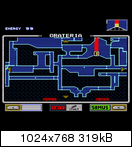[QUOTE=Sp00kyFox;35348]@Hyllian
nice to see that the metric helps you too! as I was starting with the development of ScaleFX I tested several fast methods for color metrics but this one was surely the best. yeah it costs more but still more performant than going the full way and doing a Lab-colorspace conversion. feel free to use my implementation for it. it just looks a litte convoluted since I implemented it in a way so it does 4 metric calculations at once which should be faster than doing them individually but I didn’t change the formula itself apart from inversing the result and scaling it to [0,1]. you can also get rid of the square root by squaring your threshold value which you only need to do once if it is constant. I coudn’t do it in my case since I needed to use the metric result as the output of a shader pass and without the square root there is a noticeable precision loss due to the frame buffer. here is the “clean” float4-version if you have a use for it:
the result of df(A,B) is the squared difference of (A.x, B.x), (A.y, B.y), (A.z, B.z) and (A.w, B.w). maybe you have another idea to speed it up?[/QUOTE]
I didn’t use your function because my cg compiler was complaining about using too much registers. For some reason, if you pass matrices to functions, the compiler uses more registers than if you just use vectors.
I had to modify the original params (2, 4, 3) too. For some reason they provide wrong results for my pixel art test images. So I tweaked them and found some good triplets: (17, 20, 3) or (3, 6, 1). The default now is (17, 20, 3).
I’m using the sqrt return because I need to compare accumulated distances. For example, If I had 4 color distances d1, d2, d3 and d4:
d1 = 1, d2 = 6
d3 = 4, d4 = 4
d1^2 = 1, d2^2 = 36
d3^2 = 16, d4^2 = 16
so, if I use the sqrt, then (d1 + d2) < (d3 + d4). On the other hand, if I don’t use the square root, then (d1^2 + d2^2) > (d3^2 + d4^2).


















